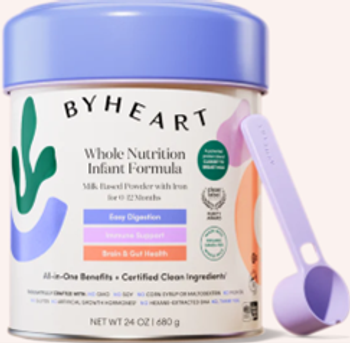
Diagnosing cow’s milk allergies in newborns and infants
Although it's one of the most common food allergies, the diagnosis of cow's milk allergies isn't always easy.
Cow’s milk allergies are among the most common types of food allergy in early childhood, but proper diagnosis and management of this condition can be complex. There are a number of different ways these allergies can develop and present in newborns and infants.
Allergic reactions to cow’s milk can include anaphylaxis in some babies, making it a potentially fatal allergy. However, because other symptoms—like crying and rashes—are more ubiquitous, some studies suggest that newborns and infants have been overdiagnosed with cow’s milk allergies.
Cases of milk allergies in infants and young children have risen in the last few decades.1 Cow’s milk allergies can be immunoglobulin (IgE)- or non-IgE-mediated, so the first step for most infants is figuring out which category the suspected allergy falls in to. Cow’s milk allergies are suspected in up to 3% of children aged younger than 4 years, but less than 1% are suspected to have non-IgE allergies.2
For most infants with IgE-mediated allergies, symptoms appear almost immediately, usually within minutes of ingesting a cow’s milk product. With non-IgE-mediated cow’s milk allergies, symptoms can take 2 hours or more to develop.1
The problem with diagnosing non-IgE-mediated cow’s milk allergies in infants is that there’s no skin prick or blood test to diagnose it. Elimination-reintroduction techniques are the most reliable diagnostic method, according to guidelines released in 2017.1
Jaclyn Bjelac, MD, a pediatric allergist and immunologist and associate director of the Food Allergy Center of Excellence at Cleveland Clinic Children's in Ohio says a board-certified pediatric allergist/immunologist is the best partner for pediatricians when it comes to determining what type of cow’s milk allergy an infant is experiencing.
“It is important to determine what type of allergic reaction a patient is having, as the management of these conditions differs,” she explains.
Outside of elimination and reintroduction strategies, Bjelac stresses the importance of taking a thorough allergy-focused clinical history.
Some guidelines suggest the following information be a part of the history assessment1:
- A family history of atopic disease in parents or siblings
- History of early atopic disease in the infant
- The infant’s feeding and growth history
- Allergy symptoms that are consistent with cow’s milk allergies
- A history of any previous treatment methods or diet changes
“The history is the most important piece of information in determining what type of reaction a patient is having—far moreso than any available test,” Bjelac says. “If a child is tolerating cow’s milk without any symptoms of an allergic reaction, it is very important to have the child continue to consume milk as avoidance may lead to the development of anaphylactic potential to cow’s milk. We do not recommend broad food allergy testing for any condition, including eczema.”
Bjelac says there are some differences in symptoms between the different subgroups of cow’s milk allergies that can help lead to a diagnosis. IgE-mediated reactions to cow’s milk follow “classic” food allergy symptoms like hives, nasal congestion, red or watery eyes, vomiting, coughing, or wheezing within minutes or up to 2 hours. This type of allergy is immune system related, and appears similar to other allergic reactions, even potentially including anaphylaxis.
Non-IgE-mediated cow’s milk allergies can also appear with vomiting, but are often accompanied by symptoms like crying and diarrhea. Because these symptoms are common in infants and small children, they can be confused with normal infant behavior.
Another consideration in diagnosing cow’s milk allergies, Bjelac says, is that these symptoms would only appear after ingestion of formula or food that contains cow’s milk.
“These reactions would not be expected from exposure to cow’s milk protein present in breast milk,” she explains.
A 2020 study published in JAMA revealed that many of the guidelines on cow’s milk allergies published over the last decade are inconsistent and conflicts of interest may be a factor in their recommendations. According to the report, proven cow’s milk allergies are present in about 1% of infants, but more generic symptoms in unproven cases—like crying, vomiting, and rashes—are reported in 15% to 20% of babies who have not received a formal diagnosis. In most children—99%—with proven cow’s milk allergies, mothers who consumed cow’s milk didn’t pass enough allergens through their breast milk to affect their infants.3
The review also found that 3 of the 9 guidelines studied in the report were supported by infant formula makers or marketing firms, and 81% of guideline authors had a conflict of interest with formula companies.3
The problem is that for non-immediate symptoms that usually signal non-IgE allergies, diagnosis is primarily subjective and based on clinical presentation. In some cases, tests like endoscopy or biopsy may be performed to exclude other disorders, says Kirsi Järvinen-Seppo, MD, PhD, chief of pediatric allergy and immunology and director of the Center for Food Allergy at the University of Rochester Medical Center in New York.
Accurately diagnosing cow’s milk reactions is important because these allergies can be life-threatening.
“If symptoms are consistent with an immediate reaction such as hives or immediate vomiting, wheezing, swelling, referral to an allergist is indicated to rule out IgE-mediated allergy, which is positive in skin test and/or blood test for IgE,” says Järvinen-Seppo. “These patients need to have access to epinephrine autoinjector, as these symptoms can progress to an anaphylactic reaction.”
All patients with this allergy should be referred to a board-certified pediatric allergist/immunologist for counseling on when it is safe to trial certain forms of cow’s milk, and to discuss possible treatment, though approximately 80% of children with milk allergy will naturally outgrow this by middle school.
References
- Venter C, Brown T, Meyer R et al. Better recognition, diagnosis and management of non-IgE-mediated cow’s milk allergy in infancy: iMAP—an international interpretation of the MAP (Milk Allergy in Primary Care) guideline. Clin Transl Allergy. 2017;7(1). doi:10.1186/s13601-017-0162-y
- Jarvinen-Seppo, KM. Milk allergy: Clinical features and diagnosis. Updated March 29, 2021. Accessed August 25, 2021. https://www.uptodate.com/contents/milk-allergy-clinical-features-and-diagnosis
- Munblit D, Perkin MR, Palmer DJ, Allen KJ, Boyle RJ. Assessment of evidence about common infant symptoms and cow’s milk allergy. JAMA Pediatr. 2020;174(6):599–608. doi:10.1001/jamapediatrics.2020.0153
Newsletter
Access practical, evidence-based guidance to support better care for our youngest patients. Join our email list for the latest clinical updates.








